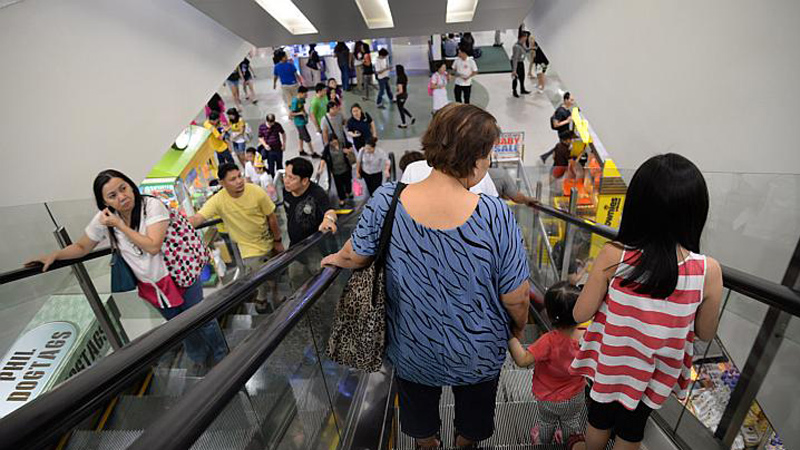
In Manila, an escalator – as long as it’s moving – is meant to be stood on. People don’t clear the right-hand side to give way to those in a hurry. Anyone trying to move past other people on a moving escalator is considered boorish. — ST PHOTO: RAUL DANCEL
A month in Manila, and I am dazed and confused—even terrified.
For seven years, Singapore was my home, and it was very good to me. It kept me safe and comfortable, and I knew I could always count on it.
I could always jog around Yishun park in the wee hours of the morning, certain no one with a gun in his hand would jump out of a bush to relieve me of my iPhone and running shoes.
I knew that when I turned on the tap, water would flow from it—sweet water I could drink. I never had to worry about an hours-long blackout in the middle of a hot, humid, mosquito-infested night.
Buses mostly arrived on the dot, and the train schedules were so predictable I could arrange to meet someone right inside the train. All I had to do was provide the time I’d get on the train at my station and which carriage I would be in—near the front, somewhere in the middle, or farther back.
Then, last month, The Straits Times sent me to Manila to work from there as its Philippines Correspondent.
I grew up in Manila. I spent more than three-fourths of my 40-odd years there.
In the past seven years, however, Manila had been more or less like Las Vegas or Disneyland: I returned to break the monotony, enjoy the place, even when I suspected I was being had.
I could stand all the inanities and profanities Manila could throw at me because I knew that, in the end, I would be heading back to Singapore.
In Singapore, I always enjoyed the cab ride from the airport to my humble flat in Yishun after each long vacation in Manila.
In that precious hour, I’d peer out the window and take in everything I missed about Singapore: the clean streets; the wide, smooth roads; the Lego-like, perfectly stacked HDB blocks; the magnificent skyline; and the uncle behind the wheel talking about everything from the weather to politics and foreign affairs.
I left Singapore on Feb 18, and I don’t think I’ll be back any time soon. The uncertainty has been particularly jarring.
I know Manila, and I speak its language, but having been away for seven years has frankly made it somewhat a stranger, and I think it finds me odd as well.
I sometimes speak in a funny way, for instance.
Here in Manila, words like “take-away”, “having here,” “lift” and “going back,” not to mention “tapao” and calling any senior citizen “uncle” and white guy “ang mo,” are taken differently.
Here, it’s “take-out”, “dine-in”, “elevator” and “heading home.” “Uncle” is reserved for your father’s brother. “Ang moh”? That’s just an alien word.
The other day I told a cashier at a KFC outlet that I’d “take away” my two-piece chicken with rice, and she insisted I meant “take out.” I said “take away” three more times before I gave up when she started looking at me like I didn’t know how to speak English properly.
“Take out,” I conceded.
So far, I have managed not to say “lift” when looking for the “elevator,” and I haven’t asked anyone packing their bags and getting ready to head home if they’re “going back.”
But I still ask for the “toilet” or “loo” whereas people here say “restroom” or “comfort room.” The euphemism, though, is misplaced because over here, these rooms rarely offer either “rest” or “comfort.”
The toilets at the malls are fine, but anywhere else, it’s pretty much a lottery draw: You’ll be lucky if you can find a cubicle with toilet paper or one, just one, unclogged receptacle.
Over the past month, I’ve been trying to stay true to my Singapore etiquette, but it just makes me look like a self-righteous weirdo here.
Here, a moving escalator is meant to be stood on. People don’t clear the right-hand side to give way to others in a hurry. The escalator moves so you won’t have to—that’s the philosophy here. Anyone trying to hurry on an escalator is considered boorish and pushy.
Out on the street, zebra crossings are little more than street art. Pedestrians don’t use them. They cross the road whenever and wherever they like and as if they just woke up with a hangover and are heading for the “comfort room,” half-asleep.
People are often seen crossing the road right below an overhead bridge, too.
Motorists who honk at jaywalkers are lucky to get the evil eye. More often, the response is a sharp rebuke: “Go fly!” Or, “Buy the road, jerk!”
Manila’s many other peculiarities are now becoming familiar once more.
Like the security guards. They’re everywhere, guarding every doorway they can plant their shiny, black, plastic boots on.
They stand at the entrances of malls and carparks, in their white and blue uniforms, poking through bags with little sticks and metal detectors and patting everyone in a manner that verges on groping.
They guard banks, restaurants, schools, grocery stores, Internet cafes, street corners, gated communities. I have yet to see a pair, though, in front of a comfort room.
The irony is that, despite their ubiquitous presence, they seem to do little more than impede the flow of human traffic. They mostly just stand at their posts and go through the motions.
Yet, through it all, despite the occasional aggravation and the mild culture shock, I know that after seven years away, I’m back home.
Manila may have its warts and quirks, but when I take a step back, I know that these are precisely what makes the place interesting. It’s not Singapore, I know that too.